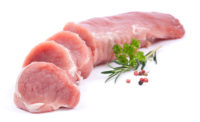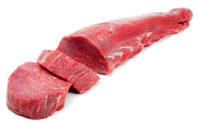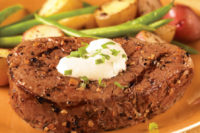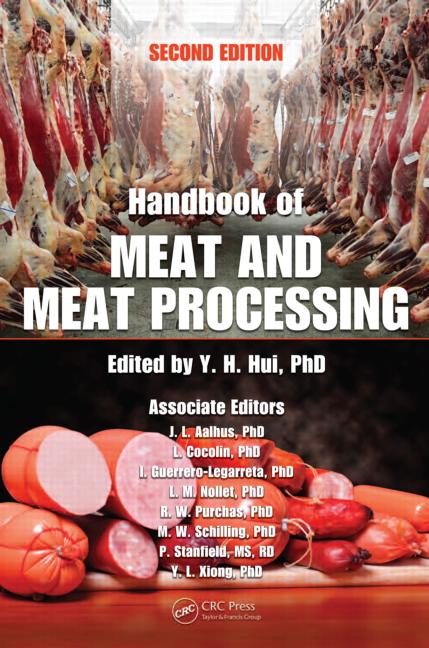Processing Tech
Challenges of whole-muscle processing
Chasing convenience and consistency




As with the entire food industry, whole-muscle processors face the challenge now of feeding an increasing number of people regardless of population growth projections. Processors are trying to feed more people with fewer resources, which ultimately means processors are raising larger animals through improvements in genetics and nutrition. Through increased efficiencies, the industry has been achieving more protein per animal unit. Larger animals, though, mean larger carcasses, and with larger carcasses come larger cuts. Fitting larger cuts into smaller-cut methodology is an active development area of whole-muscle processing.
“One of the big challenges we have in fresh meats right now is getting a larger carcass with larger cuts to meet the modern consumer’s needs, who is not necessarily looking for that size,” says Ryan Cox, associate professor of meat science at the University of Minnesota in St. Paul.
For example, a T-bone or porterhouse steak can be very large, but today even ribeye and New York strips are large. Larger pork chops and larger pork roasts are other cuts that, because of their size, can be cost and time prohibitive for shoppers at retail and diners in restaurants, Cox says.
“Even things that were normally sold large like roast or bone-in roast, in particular, people aren’t buying in retail anymore because of the convenience factor since they take longer to prepare,” he explains.
The challenge becomes finding different ways to process traditional cuts yet maintain their identity as a steak, roast, etc. The beef industry has addressed the challenge of larger sizes with alternative merchandising such as band cuts, as the industry calls them. For example, a traditional New York strip cut in half would then become a Manhattan steak.
“It creates a portion that’s a lot more appealing,” Cox explains. “It creates a price point that’s a lot more appealing. The convenience of it is certainly appealing as it takes a lot less time to cook and prepare.”
When processing whole-muscle products, processors also are working with the inherent biological variability of the muscle of the animals from which it is derived. For example, beef muscles provide a challenge in terms of the connective tissue that defines the muscle structure. It tends to be more resistant to heating and often requires some mechanical treatment in order to minimize its impact on the shape and tenderness of the product.
“Any type of whole-muscle product, if you’re talking about a ham product, if you’re talking about roast beef, if you’re talking about a turkey breast, there is variation,” explains Edward Mills, associate professor of meat science for Penn State in University Park, Pa. “Since it’s whole muscle and it’s coming right from the animal, the natural shape of the muscle and the natural morphology of the muscle introduces variation. Oftentimes we want to try to minimize that variation, because we want the finished products that we’re producing to be uniform — more uniform maybe than the raw material that we’re starting with.”
For situations in which processors need to have the muscle conform to a particular shape or respond uniformly to cooking, blade tenderization and macerators are the leading solutions for biological variation.
“Those really are the techniques that have allowed us to supply very, very uniform product and to be assured of the consistency of the product that we’re producing,” Mills says. While some improvements and variations of these mechanical processes have developed, processors have used these techniques for decades, he adds.
Quality and food safety
Cox sees convenience as another major factor affecting the processing of whole-muscle products with consumers’ shift to online shopping.
“With Amazon and all the other services doing very well, more and more product is getting delivered to the consumer, and it would stand to reason that food is going to continue that direction as well,” he says. “Especially the red meats industry is putting cuts out that are perishable. They’re incredibly perishable when they’re fresh meat. We have to consider that, and so there will be increased pressure as there already has been on packaging technology as well as the safety sector in maintaining the safety of those products.”
For example, a perishable product that requires refrigeration may arrive in a larger size and needs to be cut to portion and then also needs to get to the consumer via different methods.
“What I’m seeing is increased scrutiny of alternative packaging, and so packaging is a fairly complex consideration itself because it embodies obviously quality as well as safety, portion, logistics, etc.” Cox says. “There’s a lot of effort there right now.”
Smart packaging is hitting shelves with a visual indicator of shelf life of the product beyond just a date, Cox adds. In further regard to food safety, increased evaluation of bacteriophage technology as another intervention hurdle for ensuring the safety of fresh whole-muscle products continues to develop, he says.
Product safety concerns will continue for whole-muscle processors. “All products in almost any category, if we’re not selling ready-to-eat product right now, there is an opportunity to move in that direction,” Mills says. “With that comes the requirement to really apply a very high standard of safety to delivering those products.”
While many of the advancements with whole-muscle processing have to do with fabrication, a certain amount of automation does exist. That area continues to grow, but not all areas of whole-muscle processing can be automated, Cox says.
“As we continue to improve consistency of carcass size, thus, the machining becomes easier and becomes more automated,” he explains. “Those are some of the advancements that we continue to work on — streamlining that process. It’s something that’s done very well in poultry and to a certain extent in pork. We’re definitely doing more and more in beef as well.”
Ease of preparation
For those processors who are not dealing with fresh product, additional challenges develop when processing whole-muscle products. For example, when they cook a whole-muscle product in a traditional oven, they risk drying out the meat.
“Some companies will use a spiral steam oven to try to mitigate that fact,” explains Christopher Hansen, Auroa, Ill.-based OSI Group’s assistant vice president and culinary executive chef. “OSI has been using and perfecting sous vide processing, to maintain moisture and produce tender and juicy whole-muscle products without any yield loss. With the sous vide process, meat is packaged and sealed raw in plastic pouches then immersed in a hot water bath to gently cook it for an extended period of time at a precise temperature. This gives you a consistently flavorful and moist product.”
One of the best approaches has been to home in on the time and temperature combination within the sous vide process to create the optimum flavor, texture and moisture content for each item.
“Within the sous vide process, we can use different seasoning blends to complement the natural juices of the meat and create sauces and gravies within the plastic pouches used for immersion,” says B.K. Girdhar, OSI’s vice president of global product development. “This allows us to produce multiple flavor profiles for a variety of different protein types.”
Whole-carcass utilization also is trending, as chefs try to get all they can out of the animal. In turn, OSI’s Hansen sees more bone-in cuts being used. In addition, while the sous vide process is not new to OSI, it may still be considered innovative to some companies that use more traditional methods, such as standard or spiral steam ovens. “Sous vide by far delivers better texture and flavor to these whole-muscle cuts, which are often considered high-end, high-quality menu items,” Girdhar explains.
From large processors to small processors, the industry is trying to get the fresh-meat product as close to the meal event as possible with improved convenience and appealing attributes for products sold at retail. For example, pre-marinated proteins are offered.
“We’re marketing a steak with a vegetable and starch all together in a package that will have very explicit directions on how to prepare it or having even RTE products or products that are precooked or heated and then sold as well,” Cox says.
Mills has seen a lot of innovation in the area of cure applications and a return to Old World-type processes for charcuterie types of items. “In those, probably the biggest innovations that are occurring are in the area of clean-label ingredients,” he says.
For example, naturally cured products now have typical cured meat characteristics. Natural ingredients, such as celery juice powder, have greatly improved the consistency of cure color outcome and can be used like traditional cures, Mills explains.
Mills sees clean-label considerations driving innovation for whole-muscle products. “When we make clean-label adjustments in our ingredients, sometimes we give up some control in the quality of the products,” he explains. “So they will be continuing to focus on ways to assure juiciness, to ensure tenderness, to ensure color stability and flavor stability in a setting where we’re not using some of the ingredients that we have previously.” NP
Looking for a reprint of this article?
From high-res PDFs to custom plaques, order your copy today!











